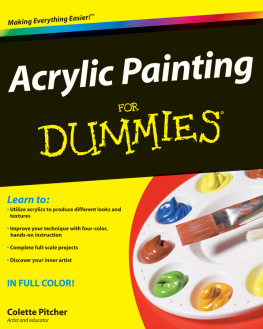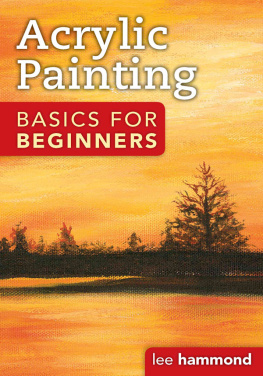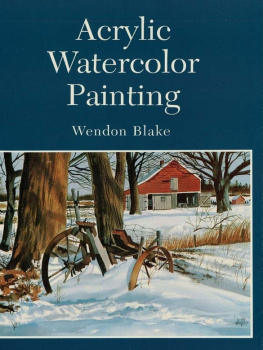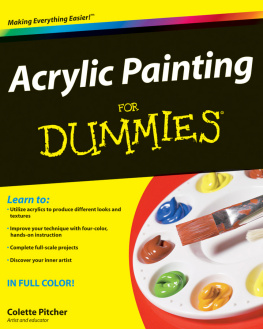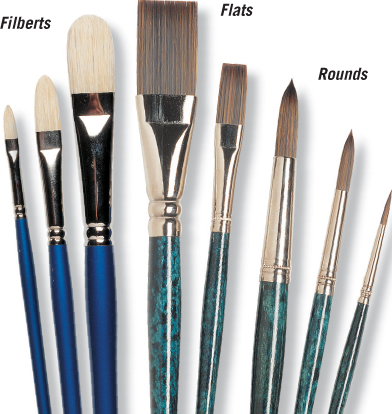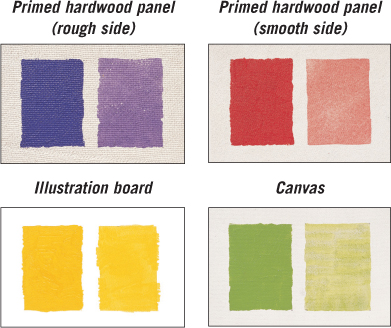Artists Library Series
Acrylic Painting Step by Step
by Tom Swimm
2005, 2011 Walter Foster Publishing, Inc. All rights reserved. Artwork 2005 Tom Swimm.
Walter Foster is a registered trademark.
This book has been produced to aid the aspiring artist. Reproduction of the work for study or finished art is permissible. Any art produced or photomechanically reproduced from this publication for commercial purposes is forbidden without written consent from the publisher, Walter Foster Publishing, Inc.
Digital edition: 978-1-61059-836-1
Softcover edition: 978-1-56010-858-0
Contents
Introduction
Since the late 1940s, interest in acrylic has gained popularity in an art world dominated by watercolor and oil paints. Acrylic paints can produce a wide range of painterly effectsfrom thin but vibrant washes to thick, impasto strokes. And this versatility has increased the demand for acrylic as a fine-art tool, delivering the medium from the realm of commercial art alone. But acrylics versatility isnt the only reason for its growing popularity. This medium also holds a number of advantages over oil and watercolor; for example, it doesnt yellow or crack over time, and it doesnt bleed under protective varnishes. Acrylic does dry quickly, though, which allows painters to apply new layers of paint or rework underlying layers without muddying the colors. In addition, acrylic paints are relatively inexpensive when compared to oil paints, and they clean up easily with plain soap and water. For these reasons and more, acrylic is an ideal medium for beginners, as well as for artists interested in exploring and experimenting with a wide array of techniques.
In this book, I will demonstrate my own approach to painting in acrylic with 12 diverse step-by-step lessons, from an intimate doorway to a grand seascape. And, accompanying each lesson, youll find all the information you need to follow along and re-create these beautiful scenes. I will also explain how to build realistic form and shape as I explore the fascinating contrasts between light and shadow. Plus I will provide plenty of inspiration for choosing your own subjects and creating your own masterpieces in acrylic!
Tools and Materials
To get started with acrylic, you need only a few basic tools: paints, brushes, supports, and water. When you buy your acrylic supplies, remember to purchase the best you can afford at the time, as better-quality materials are more manageable and produce longer-lasting works.
Selecting Paints
Acrylic paints come in jars, cans, and tubes. Most artists prefer tubes, as they make it easy to squeeze out the appropriate amount of paint onto your palette. There are two types of acrylic paints: student grade and artist grade. Artist-grade paints contain more pigment and less filler, so they are more vibrant and produce richer mixes.
Choosing Your Colors
A good beginners palette of colors consists of one warm and one cool version of each of the primary colors: yellow, red, and blue. (For more about warm and cool colors, see Exploring Color Temperature on .) Youll also want to include white, black, and a few browns, such as burnt sienna or raw umber. From these basics, you should be able to mix just about any color youll need. My basic palette consists of the 17 colors listed below.
My Basic Palette From the top moving left to right: alizarin crimson, burnt sienna, yellow ochre, Naples yellow, pink (or flesh), dioxazine purple, cadmium red light, cadmium yellow light, unbleached titanium, titanium white, sap green, emerald green, Prussian blue, phthalocyanine (abbreviated phthalo) blue, Paynes gray, light blue (or cerulean blue), and light blue-violet.
NOTE: For the projects in this book, youll also need the following colors: bright orange, brilliant blue, bronze yellow, cadmium orange, cadmium yellow medium, chromium oxide green, deep magenta, Indian red, light portrait pink, medium magenta, phthalo green, phthalo violet, raw sienna, and yellow oxide.
Buying Brushes
Acrylic paintbrushes are categorized by hair type (soft or stiff and natural or synthetic), style (filbert, flat, or round), and size. For the projects in this book, I recommend small, medium, and large sizes of both sable (soft) and bristle (stiff) brushes. Synthetic-hair paintbrushes work well with acrylic, as the bristles are soft but springy enough to return to their original form. In addition to buying brushes, youll also want to purchase a palette knife or painting knife for mixing colors on your palette and experimenting with textural effects on your canvas.
Creating a Studio
I have a very easy commute to my studioits located in my garage! With the garage door open, my workspace gets plenty of natural northern light. I also have an overhead array of track lighting so that I can work at night. Next to my easel, I have a multi-level taboret that keeps my tools close at hand. On the wall, I have pegboard for hanging works in progress as they dry.
Selecting a Support
Acrylic can be applied to almost any surface that has first been primed with gessoa water-based mixture of a chalklike substance and glue that applies like paint and makes the surface less absorbent. This material also bonds well with the paint. Many artists choose to paint on primed canvases or canvas boards, which provide a fine-fabric surface with a slight grain. Primed pressed-wood panels offer a smoother alternative to canvas, as they have a fine-grained, less coarse surface. For the projects that call for a thin watercolor effect, you can use acid-free 140-lb cold-press watercolor paper or canvas paper.
Surface Textures The surface on which you paint determines the textures of your strokes and washes. In the examples above, you can see how thick (left) and thin (right) applications of paint appear on the various supports.
Purchasing a Palette
Palettes for acrylic paints are available in many different materialsfrom wood and ceramic to metal and glass. Plastic palettes are inexpensive, and they can be cleaned with soap and water. Disposable paper palette pads are also very convenient; instead of washing away the remains of your paint, you can simply tear off the top sheet to reveal a fresh surface beneath.
Gathering the Basics
To get started, youll want to have a few household materials on hand. Youll need two jars of water: one for adding to your paint mixes and one for rinsing out your brushes. A spray bottle will help keep the paints and mixes on your palette moist, and paper towels or rags will help with cleanup. I also like to use a permanent (waterproof) felt-tip marker for sketching onto my canvas.
Next page




